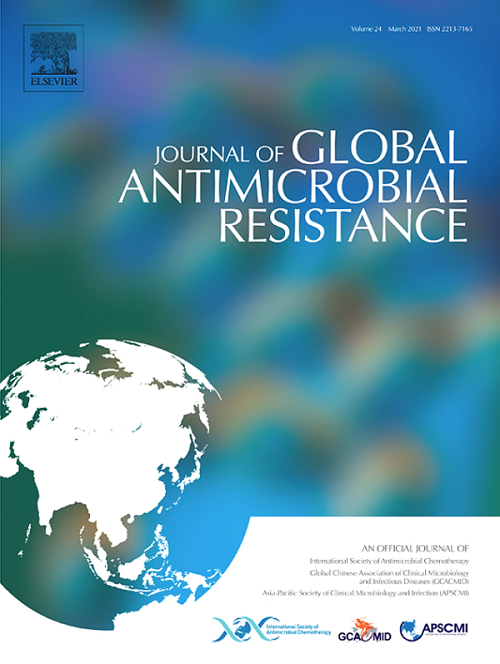台州市伊莉莎白属临床分离株的流行病学及基因组学特征
IF 3.2
3区 医学
Q2 INFECTIOUS DISEASES
引用次数: 0
摘要
目的:伊莉莎白菌通常对多种抗生素具有耐药性,不适当的抗菌治疗是伊莉莎白菌感染患者死亡的主要原因。我们的研究旨在全面分析和比较三个伊丽莎白属物种的基因组和临床特征。方法:采用基质辅助激光解吸/电离飞行时间质谱法和全基因组测序对近6年来88例患者的88株伊丽莎白菌株进行鉴定。采用系统发育树和Sankey图分析,比较了具有金属β-内酰胺酶耐药基因的菌株和49株具有进化关系的elizabeth ethkingia miricola菌株。结果:鉴定出的伊莉莎白金甲种包括按蚊伊莉莎白金甲(65/88,73.9%)、脑膜炎败血症伊莉莎白金甲(8/88,9.1%)和miricola伊莉莎白金甲(15/88,17.0%)。多因素分析显示,与铜绿假单胞菌共分离(优势比:40.83,95%可信区间:3.05 ~ 546.29,p = 0.005)和抗菌药物暴露于碳青霉烯类(优势比:5.76,95%可信区间:1.00 ~ 248.32,p = 0.050)是院内死亡的独立危险因素。全基因组测序和系统进化树分析显示,88株菌株均有22个BlaBlaB变异和19个BlaGOB变异。特别是,BlaB和GOB亚型的具体组合在三个伊丽莎白金属物种中有所不同。所有elizabeth ethkingia种均含有耐药基因adeF、vanT和vanW,并共享32个毒力相关基因。全球系统发育演化表明,中国临床分离株存在弥散性,不存在爆发的可能性。结论:抗性和毒力基因的变异与elizabeth ethkingia的自然抗性和致病性有关。建议增加基因组监测,以便更深入地了解elizabeth ethkingia spp的致病机制。本文章由计算机程序翻译,如有差异,请以英文原文为准。

Epidemiological and genomic features of clinical isolates of the Elizabethkingia genus in Taizhou City, China
Objective
Elizabethkingia species usually exhibit resistance to multiple antibiotics, and inappropriate antimicrobial therapy is a major cause of mortality in patients with Elizabethkingia infection. Our study aimed to comprehensively analyse and compare the genomic and clinical features of three Elizabethkingia species.
Methods
Matrix-assisted laser desorption/ionization–time of flight mass spectrometry and whole-genome sequencing were used to identify 88 Elizabethkingia isolates from 88 patients in the past 6 y. Phylogenetic tree and Sankey diagram analysis were used to compare the strains with metallo-β-lactamase resistance genes and 49 Elizabethkingia miricola strains with evolutionary relationships.
Results
The identified Elizabethkingia species included Elizabethkingia anophelis (65/88, 73.9%), Elizabethkingia meningoseptica (8/88, 9.1%), and E. miricola (15/88, 17.0%). Multivariate analysis showed that co-isolated with Pseudomonas aeruginosa (odds ratio: 40.83, 95% confidence interval: 3.05–546.29, P = 0.005) and antimicrobial exposure to carbapenems (odds ratio: 5.76, 95% confidence interval: 1.00–248.32, P = 0.050) were independent risk factors for in-hospital mortality. Whole-genome sequencing and phylogenetic tree analysis revealed all 88 strains with 22 BlaBlaB and 19 BlaGOB variants. In particular, the specific combinations of BlaB and GOB subtypes differed in three Elizabethkingia species. All Elizabethkingia species harboured drug-resistance genes adeF, vanT, and vanW and shared 32 virulence-associated genes. Global phylogenetic evolution of E. miricola showed a dispersal in Chinese clinical isolates and did not display outbreak possibility.
Conclusions
Variations in resistance and virulence genes are associated with the natural resistance and pathogenicity of Elizabethkingia. Increased genomic monitoring is recommended for a deeper understanding of the pathogenic mechanisms of Elizabethkingia spp.
求助全文
通过发布文献求助,成功后即可免费获取论文全文。
去求助
来源期刊

Journal of global antimicrobial resistance
INFECTIOUS DISEASES-PHARMACOLOGY & PHARMACY
CiteScore
8.70
自引率
2.20%
发文量
285
审稿时长
34 weeks
期刊介绍:
The Journal of Global Antimicrobial Resistance (JGAR) is a quarterly online journal run by an international Editorial Board that focuses on the global spread of antibiotic-resistant microbes.
JGAR is a dedicated journal for all professionals working in research, health care, the environment and animal infection control, aiming to track the resistance threat worldwide and provides a single voice devoted to antimicrobial resistance (AMR).
Featuring peer-reviewed and up to date research articles, reviews, short notes and hot topics JGAR covers the key topics related to antibacterial, antiviral, antifungal and antiparasitic resistance.
 求助内容:
求助内容: 应助结果提醒方式:
应助结果提醒方式:


